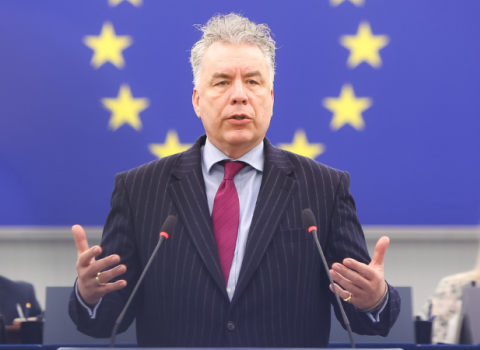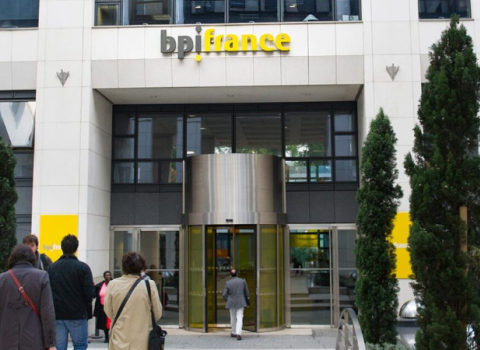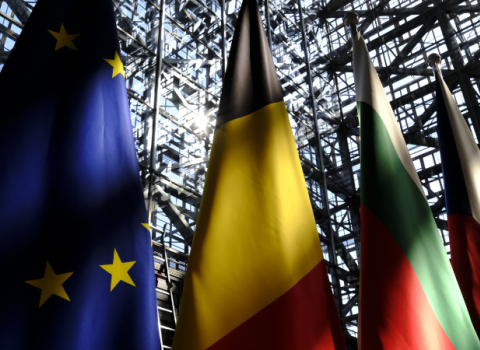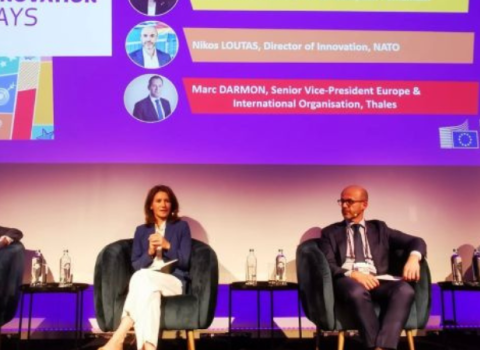EU governments want to attract more investment in defence, but a lack of public funding and collaboration is holding industry back, business leaders said on Wednesday

European Commission president Ursula Von der Leyen speaking at the European Defence & Security Summit 2024, on April 17, 2024. Photo credits: Aurore Martignoni / European Union
Following the shock of Russia’s invasion of Ukraine, defence spending and R&D has jumped up the EU’s list of priorities, with calls from some quarters for a ‘war economy’.
Now member states need ensure these efforts to enhance defence capabilities benefit European manufacturers, says Micael Johansson CEO of Swedish weapons manufacturer SAAB. “We can’t spend money on R&D, collaborating through the European Defence Fund (EDF), which is good, but then when we get to industrialisation and production, spend lots of money outside the EU,” he told the European Defence and Security Summit in Brussels on Wednesday.
Johansson was reflecting on the fact that EU member states have raised their defence budgets by 20% since Russia’s invasion of Ukraine in February 2022, but that 78% of all military equipment Europe has sent to Ukraine was purchased from non-EU manufacturers.
There are moves afoot to change this, and last month the Commission unveiled its first-ever European Defence Industrial Strategy (EDIS), including a proposal for a European Defence Industry Programme (EDIP) to mobilise €1.5 billion between 2025 and 2027 to support ammunition production and joint procurement.
But, said Johansson, the €1.5 billion allocated to EDIP is “far from enough” and should not – as is proposed - be transferred from EDF, which funds collaborative R&D projects. “It needs to be fresh money,” he said.
Jan Pie, secretary general of the Aerospace, Security and Defence Industries Association of Europe, told the summit that the industry has, “stretched as far as it can when it comes to taking risks.” Instruments like EDIP will only make a difference if there is sufficient buy-in from member states.
That is not the case today, Pie said. “I have heard so many prime ministers say that investing in defence is sustainable,” he said. “Still, there are tons of eco-labels out there across member states that put defence in the same category as tobacco and alcohol.”
The €1.5 billion funding for EDIP is a far cry from the €100 billion originally suggested by Thierry Breton, internal market commissioner. But speaking at the summit, Breton defended it as representing a “quantum leap” compared to previous EU action on defence.
“We need to put more actions where our words are,” said Camille Grand, policy fellow at the European Council on Foreign Relations think tank. “I’m not sure we have moved at pace from that type of high-level political statement to the reality.”
European awakening
Speaking in the aftermath of Iran’s attack on Israel, European Commission president Ursula von der Leyen told the summit that the escalating threat to security “require(s) a new European defence mind-set, from member states, to institutions, to industry to investors.”
Iran’s launch of more than 300 drones and missiles targeted at Israel represents “a shift towards open confrontation” using modern weapons. It underlines “the real value of consistent long-term investment in advanced defence capabilities and technologies,” von der Leyen said.
The EU will “focus on innovation to ensure Europe has the edge in the new technologies, which we see being deployed across the world in different conflicts,” said von der Leyen.
Von der Leyen also highlighted the importance of collaboration with countries such as Ukraine and the UK. “The door is open for partners to join, for partners to be included in our Defence Industrial Programme,” she said.
However, unlocking EU funds for defence innovation has not proved easy. The proposed EDF budget was originally €13 billion for 2021-2027, but it was cut to €8 billion because of the COVID-19 pandemic. An additional €1.5 billion was allocated to EDF as part of the Strategic Technologies for Europe Platform (STEP). However, this is now set to be transferred to EDIP.
NATO is also funding innovation through the DIANA dual-use accelerator programme, as well as the €1 billion Innovation fund for deep tech. “We’re hoping to raise that, with two or three new countries joining, to €1.5 billion,” said James Appathurai, NATO’s deputy assistant secretary general for innovation, hybrid and cyber.
The Innovation fund “will crowd in, according to our estimates, another €15 to €30 for every euro we invest,” he said, adding that there was also a growing interest from industry in response to Russia’s invasion of Ukraine.
“Four years ago, a lot of dual-use companies, tech firms, leaned away from NATO and from defence. Now they’re knocking on our door because they understand we need defence to preserve our shared security,” Appathurai said.
Common market for defence
The summit was on the same day as former Italian prime minister Enrico Letta published his long-awaited report on the single market, in which he urges the EU to develop a common market for security and defence.
“Our industrial capacity in the fields of security and defence must undergo a radical transformation to avoid repeating the dynamics observed during 2022-2024,” says the report, which was commissioned by the European Council.
This is a reference to the EU’s dependence on third countries for weapons and equipment, which Letta says is exacerbated by underinvestment and a fragmentation of demand across Europe.
There should be public support for a “defined set of critical projects of common interest”, starting with joint research, to be delivered through, “a single instrument covering the capability’s life-cycle, from the design phase to joint acquisition to in-service support.”
Long-term planning would derisk production and provide predictable orders, while joint development and acquisition would reduce costs by fostering economies of scale, making member states less reliant on purchasing from third countries.
The report also underlines the need to align EU and NATO capacity building efforts to avoid duplication, and to harmonise strategic planning.
It calls for more cooperation between companies, and for incentives for larger companies to “integrate and mentor” innovative start-ups and SMEs, as the latter will be crucial to the development of dual-use technologies.
Letta also recommends “innovative” financing instruments to encourage more private investment. “This could involve ensuring a portion of the risks tied to the financed project, offering guarantees for loans or certainty on future public procurements,” he writes.
Following pressure from member states, the European Investment Bank last week announced it would waive the requirement for dual-use projects with civilian and defence applications, to derive more than 50% of their expected revenues from civilian applications.
This is something defence companies have been calling for, and they hope it will send a signal to other investors, notably large pension funds, that they should no longer shy away from the sector.
The Letta report was published after the European Council in the conclusions for its March meeting invited the Council and Commission to explore options for mobilising funding and to report back in June.
EU leaders recognised the need for joint defence investment, “From the research and development to the planning stage, to industrialisation and joint procurement.”
Letta presented his report to EU leaders at a special European Council summit today. While discussions were supposed to focus on EU competitiveness, this was overshadowed by the latest developments in the Middle East.





 A unique international forum for public research organisations and companies to connect their external engagement with strategic interests around their R&D system.
A unique international forum for public research organisations and companies to connect their external engagement with strategic interests around their R&D system.